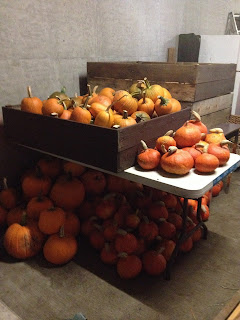We have been having some very soggy, grey weather here on the "Wet Coast" for the past couple weeks, but once again we were lucky to have nice, rain-free morning for our last Agroecosystems class at the Orchard.
I got to the Orchard a bit early before all the activity of the day started, and I was rewarded for my punctuality by being witness to a beautiful Great Blue Heron (Ardea herodias fannini) in what had previously been our corn and bean field. The Great Blue Heron is classified as "Special Concern" here in BC by the Committee on the Status of Endangered Wildlife in Canada (COSEWIC), meaning that they "may become a threatened or an endangered species because of a
combination of biological characteristics and identified threats".
Great Blue Herons feast mainly on small fish and other aquatic life such crabs, crayfish, frogs, and salamanders. However, they have been known to opportunistically feed on small field rodents. Here's hoping that our heron helped himself to a breakfast of some of our pesky voles while he was visiting the orchard this morning!
 |
| Our Great Blue Heron visitor |
The Great Blue also checked out the garlic plots we planted last week (can you see him to the right?).
 |
| Garlic plots planted last week |
Our class also got to welcome the newest member of the Sustainable Agriculture and Food Systems team at KPU, Torin Boyle! Torin has moved from his home in Ontario to be the new Research & Education Laboratory Farm Coordinator. Welcome Torin!
 |
| Torin Boyle, new farm coordinator |
The main task we needed to get done today before we could officially put the orchard to bed for the year was to get the Styrian pumpkins out of the pumpkin patch.
A few weeks ago we harvested all of the other pumpkins from the field, but we left the Styrians because we are running a trial on them. The Styrian pumpkin (Cucurbita pepo subsp. pepo var. Styriaca) is a hull-less variety of pumpkin, which means that it works great for crushing to extract pumpkin seed oil, as well as eating the raw seeds (see "Random Facts about Styrian Pumpkins" at the end of this post). Nature's Path here in Richmond is interested in using pumpkin seed oil in their organic prepared products, as it is difficult to find non-GMO canola oil. The company asked us earlier in the year to grow the pumpkins and record the data regarding seed size, number, weight, etc. We found Styrian pumpkin seeds from two suppliers: An Austrian company (which were quite expensive) and from a North American company, Strictly Medicinal Seeds (much cheaper).
We grew the pumpkins from the two different sources side by side in order to compare the size and quality of the two different seeds. However, after a season's worth of growth, we realized today that it was challenging to separate the vines and sort out which pumpkin came from which source! We did the best we could to distinguish the two, and then harvested the rest.
After we got all the pumpkins out, we removed the plastic mulch that we had laid down to suppress weeds and stored it for use next year.
After the plastic mulch was removed, we raked the area by hand and prepared the area to plant a cover crop on.
We choose a cover crop of winter wheat and white clover to plant on the area.
And with that, the Orchard Farm gardens were officially put to bed until next year's new crop of Agroecosystem students return for another season of planting!
********************************************************************
Random Facts on Styrian Pumpkin Seed Oil*
- The hull-less Styrian pumpkin variety first appeared in the early 19th century in the province of Styria in the southeastern region of Austria.
- The hull-less trait resulted from a naturally-occurring single recessive gene mutation in the variety that led to a very thin outer hull.
- Many cultivars have been bred from this original hull-less pumpkin to produce hull-less pumpkins with better yield, seed production, and disease resistance.
- The oil from the hull-less Styrian pumpkin is not considered a "virgin" oil because it must be roasted prior to pressing.
- Roasting allows the proteins in the seeds to coagulate and the convenient separation of the lipid fraction.
- Roasting also gives the Styrian pumpkin seed oil its distinct flavor and aroma.
- Pressing Styrian pumpkin seeds for oil is mainly a handcraft and done on a relatively small scale by local mills.
- Styrian pumpkin seed oil is light-sensitive and best kept in dark bottles.
- High quality Styrian pumpkin seed oil is a dark green color with orange-to-red fluorescence.
- Styrian pumpkin seed oil has a high content of polyunsaturated fatty acids (45.6% of total fatty acid content), followed by monounsaturated fatty acids (35.9%) and saturated fatty acids (18.5%).
*Adapted from: G.O. Fruhwirth and A. Hermetter. 2008. Production technology and characteristics of Styrian pumpkin seed oil. Eur. J. Lipid. Sci. Technol. 110: 637-644.










 S
S













